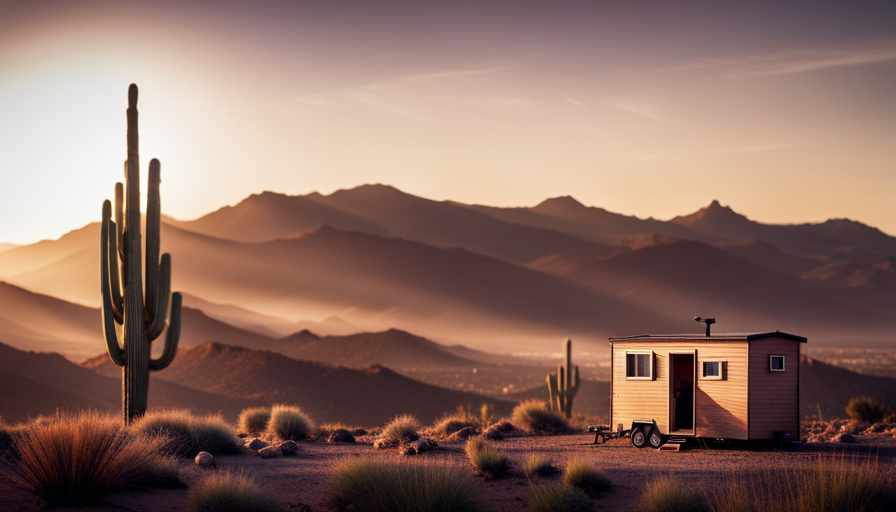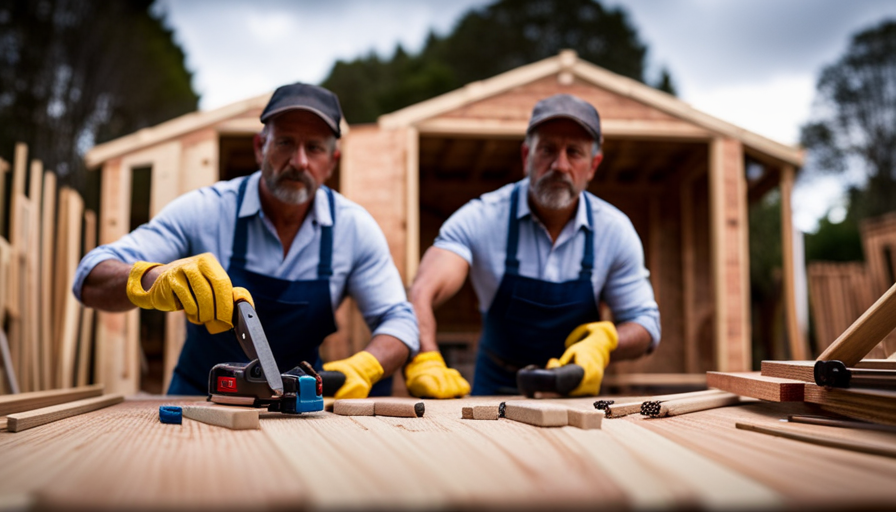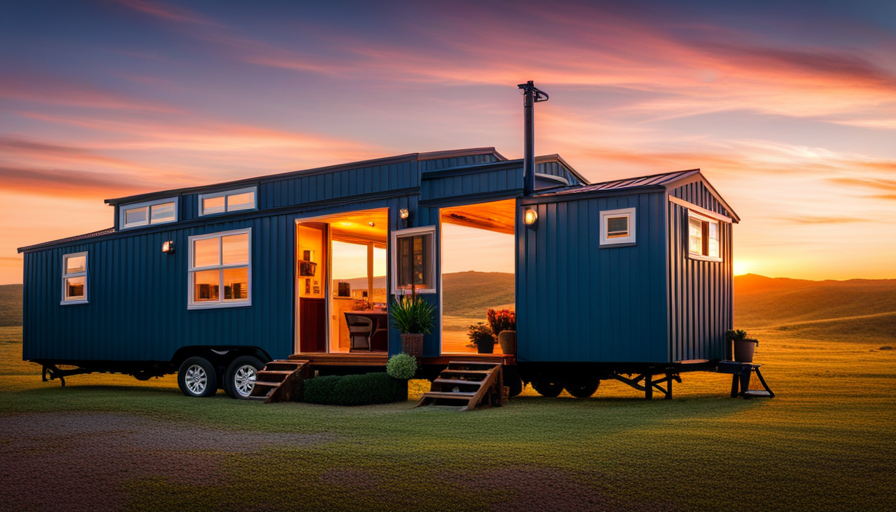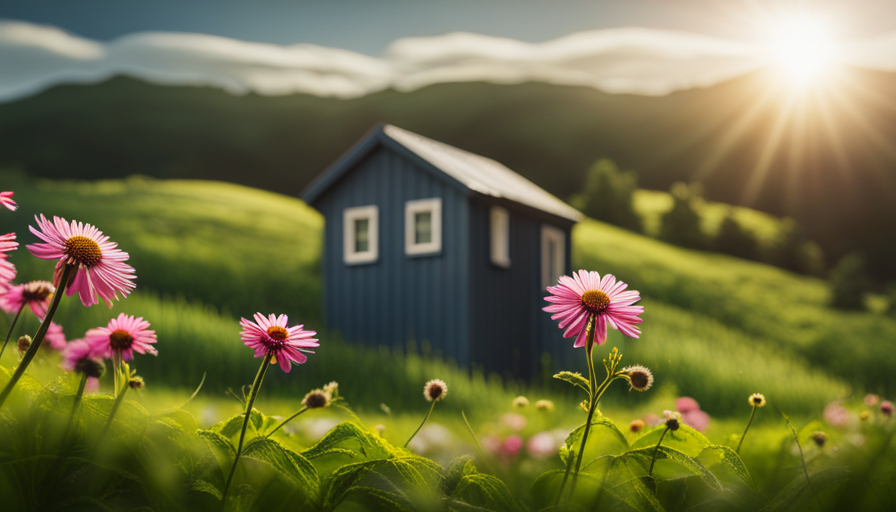Constructing a small house in Arizona is akin to starting an exciting journey, where each progress contributes to the realization of your ideal home. Similar to a puzzle, you must meticulously assemble the different components to make your vision a reality. Nevertheless, prior to delving into this project, it is essential to grasp the financial implications.
Like a master detective, I have delved deep into the intricacies of tiny house construction in Arizona, uncovering the secrets that lie within. In this article, I will guide you through the labyrinth of expenses, from materials and labor to permits and inspections. We will also explore the hidden gems of customization and interior design, as well as the financial aspects of land acquisition or renting in a tiny house community. Additionally, we will shed light on the ongoing maintenance and upkeep expenses.
So, grab your magnifying glass and join me on this enlightening journey to discover the true cost of building a tiny house in Arizona.
Key Takeaways
- Understanding the costs involved in building a tiny house in Arizona is crucial.
- Familiarize yourself with Arizona building codes and regulations to avoid legal issues.
- Consider zoning restrictions and setbacks to comply with codes and ensure safety.
- Allocate time and funds for permits, inspections, utility connections, and off-grid options to avoid delays or unexpected expenses.
Research Arizona Building Codes and Regulations
Now that you’re diving into the world of tiny house building in Arizona, let’s explore the fascinating realm of Arizona Building Codes and Regulations.
When it comes to constructing a tiny house in Arizona, it’s crucial to understand and adhere to the state’s building codes. Arizona building codes ensure the safety and structural integrity of all residential structures, including tiny houses. These codes cover various aspects such as minimum ceiling height, egress requirements, electrical and plumbing systems, and fire safety measures.
Additionally, Arizona has specific regulations for tiny houses on wheels, including weight limits and transportation regulations. Familiarizing yourself with these regulations is essential to avoid potential legal issues and ensure a smooth building process.
Now, let’s move on to the next section and determine the size and style of your tiny house.
Determine the Size and Style of Your Tiny House
First, figure out the perfect dimensions and design for your charming abode in the beautiful state of Arizona. When determining the layout and functionality of your tiny house, it’s important to consider your specific needs and preferences. Take into account the number of rooms, the size of each room, and any special features you desire.
To ensure compliance with Arizona building codes and regulations, it’s crucial to thoroughly research zoning restrictions and setbacks. Different areas may have specific requirements regarding the size, height, and placement of your tiny house. Familiarize yourself with these regulations to avoid any potential setbacks or delays in the construction process.
When considering the size and style of your tiny house, keep in mind that simplicity and efficiency are key. Maximizing space utilization and incorporating multi-functional furniture can greatly enhance the functionality of your small living space.
In the next section, we’ll delve into the calculations necessary to determine the cost of materials and labor for building your dream tiny house in Arizona.
Calculate the Cost of Materials and Labor
To figure out the total expenses for your dream mini home in Arizona, it’s time to crunch the numbers and calculate the combined cost of materials and labor. When it comes to building a tiny house, it’s important to have a clear cost estimation to avoid any surprises along the way. The cost of materials will depend on the size and style of your tiny house. For instance, if you opt for high-end finishes and appliances, the cost will be higher. On the other hand, if you choose more affordable materials, you can save some money. In terms of labor, it’s essential to consider the building timeline. The longer it takes to build your tiny house, the more you will have to pay for labor. Keep in mind that the cost of permits and inspections will also be a factor to consider. Moving forward, let’s consider the cost of permits and inspections for your tiny house in Arizona.
Consider the Cost of Permits and Inspections
Don’t forget to factor in the necessary paperwork and inspections to ensure your dream mini home in Arizona meets all the legal requirements and regulations.
When considering the cost of building a tiny house in Arizona, it’s essential to account for the cost of professional services such as permits and inspections. These services are crucial for obtaining the necessary approvals and ensuring your tiny house is compliant with local building codes.
The cost of permits can vary depending on the size and complexity of your project, as well as the specific requirements of your location. Additionally, the timeline for obtaining permits and scheduling inspections should be considered when planning your budget. It’s important to allocate both time and funds for these processes to avoid any delays or unexpected expenses.
Moving forward, let’s explore the budget for utility connections and off-grid options.
Budget for Utility Connections and Off-Grid Options
Consider exploring different options for utility connections and off-grid solutions to ensure that your mini home in Arizona has all the necessary amenities to make it comfortable and functional for your needs.
When budgeting for utility connections, one cost-effective option to consider is solar power. Installing solar panels can provide you with a sustainable and renewable source of energy, reducing your reliance on the traditional power grid.
Additionally, you should also factor in the cost of water and sewage connections. Depending on the location of your tiny house, you may need to dig a well or connect to a local water supply. Similarly, sewage connections may require the installation of a septic system or connection to a municipal sewer line.
By budgeting for these utility expenses, you can ensure that your tiny house in Arizona is equipped with the necessary utilities for comfortable living.
Moving forward, it’s important to explore financing and insurance options to protect your investment.
Explore Financing and Insurance Options
Exploring financing and insurance options can provide peace of mind and ensure that your dream of owning a cozy desert retreat becomes a reality. When it comes to financing your tiny house in Arizona, there are several options to consider.
You can explore personal loans from banks or credit unions, which may offer competitive interest rates and flexible repayment terms. Another option is to look into specialized tiny house loans, which are specifically designed for this type of housing. These loans often have unique requirements and considerations, so it’s important to do thorough research and compare different lenders.
Additionally, it’s crucial to factor in insurance coverage for your tiny house. While some insurance companies offer policies specifically tailored for tiny houses, others may require you to purchase a mobile or manufactured home policy. Understanding your insurance options and requirements is essential for protecting your investment.
As you consider financing and insurance, it’s important to also factor in customization and interior design costs, ensuring that every aspect of your tiny house meets your personal preferences and needs.
Factor in Customization and Interior Design Costs
Make sure you envision the perfect oasis that reflects your unique style and personality, because creating the perfect interior design for your cozy desert retreat is an opportunity to truly make it feel like home.
When it comes to customizing your tiny house, there are a few challenges to consider. First, the limited space may require creative storage solutions and multi-functional furniture. Second, the unique shape and layout of a tiny house can present challenges when it comes to finding furniture and decor that fit properly. Third, you’ll need to carefully plan the electrical and plumbing systems to ensure they accommodate your desired design elements. Finally, staying up-to-date with current interior design trends can help you create a modern and stylish space.
Transitioning into the next section, it’s important to consider the cost of land or renting a tiny house community space.
Consider the Cost of Land or Renting a Tiny House Community Space
Finding the perfect location for your cozy desert retreat involves factoring in the cost of land or renting a space in a tiny house community. When considering the cost of land, it’s important to compare prices in different areas of Arizona. The cost of land can vary depending on the location, size, and amenities available.
Renting a space in a tiny house community is another option to consider. While this may involve a monthly fee, it often includes amenities such as water, electricity, and waste disposal, which can help offset other expenses. Additionally, living in a tiny house community provides the benefit of a sense of community and shared resources.
Transitioning into the subsequent section about planning for maintenance and upkeep expenses, it’s essential to take into account these ongoing costs to ensure the long-term sustainability of your tiny house.
Plan for Maintenance and Upkeep Expenses
When it comes to building and owning a tiny house in Arizona, it’s important to consider the ongoing maintenance and upkeep expenses. This is the current subtopic we will be discussing. As a tiny house owner, you have the option of doing DIY maintenance or hiring professional services.
There are pros and cons to each approach. DIY maintenance allows you to save money and gives you a hands-on experience in taking care of your tiny house. However, it requires time, effort, and skills to handle repairs and regular upkeep. On the other hand, hiring professional maintenance services can save you time and ensure that the job is done correctly, but it comes with a cost.
To help you visualize the potential expenses, here is a table outlining the estimated costs of common maintenance tasks for a tiny house in Arizona:
| Maintenance Task | DIY Cost | Professional Cost |
|---|---|---|
| Plumbing Repairs | $100-$500 | $200-$800 |
| Roof Maintenance | $200-$500 | $500-$1,000 |
| Electrical Inspections | $100-$300 | $200-$500 |
| Pest Control | $50-$200 | $100-$300 |
| Exterior Painting | $200-$500 | $500-$1,000 |
Considering these costs will help you plan and budget for the ongoing maintenance of your tiny house. Now, let’s move on to the next section where we will compare the cost of building versus buying a pre-built tiny house.
Compare the Cost of Building vs. Buying a Pre-built Tiny House
Opting to construct your own cozy abode or purchase a ready-made miniature dwelling leads to an intriguing comparison of expenses. When it comes to the cost of building versus buying a pre-built tiny house in Arizona, there are pros and cons to consider.
Building a tiny house allows for customization and personalization, but it comes with the responsibility of managing the construction process and ensuring all permits and regulations are met. On the other hand, buying a pre-built tiny house offers convenience and a quicker move-in time, but it may limit the level of customization.
In terms of cost, building a tiny house can be more affordable, especially if you’re able to do some of the work yourself. However, buying a pre-built tiny house may be a better option if you don’t have the time or skills for construction.
Ultimately, the decision between building and buying will depend on your personal preferences, budget, and timeline.
Frequently Asked Questions
Are there any restrictions on the location where I can build a tiny house in Arizona?
There are restrictions on zoning when it comes to building a tiny house in Arizona. Zoning laws vary by city and county, so it’s important to research and understand the specific regulations for your desired location.
Some areas may have minimum square footage requirements or restrictions on accessory dwelling units. However, there are also tiny house communities in Arizona that are specifically designed for tiny home living, which may have more lenient zoning regulations and provide a supportive community for tiny house enthusiasts.
How much does it cost to obtain permits and go through the inspection process for building a tiny house in Arizona?
Obtaining permits and going through the inspection process for building a tiny house in Arizona can incur costs for both materials and labor. The cost of permits varies depending on the location and size of the tiny house, ranging from $500 to $2,000.
Inspections typically cost around $500.
The cost of materials can vary greatly depending on the size and design of the tiny house, but on average, it can range from $20,000 to $50,000.
Labor costs can also vary, but hiring professionals for construction can add an additional $10,000 to $20,000 to the overall cost.
What financing options are available for building a tiny house in Arizona?
There are several financing options available for building a tiny house in Arizona. One interesting statistic is that according to a survey, around 68% of tiny house owners finance their homes.
Some common financing options include personal loans, RV loans, and construction loans. Personal loans offer flexibility but may have higher interest rates. RV loans are specifically designed for recreational vehicles, including tiny houses. Construction loans are ideal for those building from scratch but require more paperwork.
It’s important to weigh the pros and cons of each option before making a decision.
What insurance options are available for tiny houses in Arizona?
When it comes to insurance coverage for tiny houses in Arizona, there are several options available. It is important to research and find the coverage options that best suit your needs. Some insurance companies offer specialized policies specifically for tiny houses, while others may offer coverage under a standard homeowner’s policy.
These coverage options can include protection for the structure, personal belongings, liability, and even coverage for when the tiny house is being towed or transported.
Is it more cost-effective to build a tiny house in Arizona or to buy a pre-built one?
When considering the cost comparison between building a tiny house in Arizona and buying a pre-built one, it’s like choosing between baking a homemade cake or buying one from a bakery.
Building a tiny house allows for customization and potential cost savings, but it requires time, effort, and expertise.
On the other hand, buying a pre-built tiny house offers convenience, but may come at a higher price.
Assessing the advantages and disadvantages of each option is crucial in making the most cost-effective decision.
Conclusion
In conclusion, building a tiny house in Arizona requires careful planning, research, and budgeting.
From understanding building codes to calculating material and labor costs, there are numerous factors to consider.
Additionally, permits, inspections, utility connections, customization, and land expenses should all be accounted for.
Maintenance and upkeep expenses should also be factored in.
Overall, building a tiny house offers the opportunity for customization and cost savings compared to buying a pre-built one.
So, if you’re looking for a unique and affordable housing option, consider the tiny house route in Arizona.
Hi, I’m Emma. I’m the Editor in Chief of Tiny House 43, a blog all about tiny houses. While tree houses are often associated with childhood, they can be the perfect adult retreat. They offer a cozy space to relax and unwind, surrounded by nature. And since they’re typically built on stilts or raised platforms, they offer stunning views that traditional homes simply can’t match. If you’re looking for a unique and romantic getaway, a tree house tiny house might just be the perfect option.










